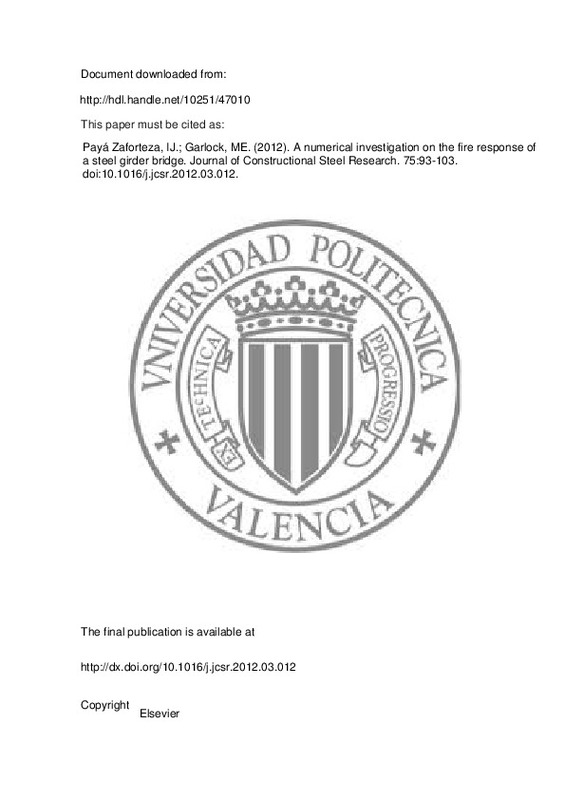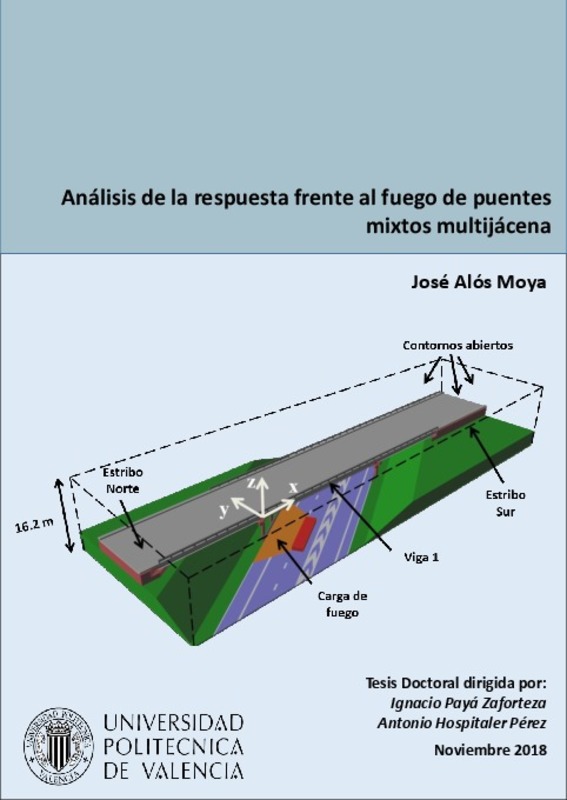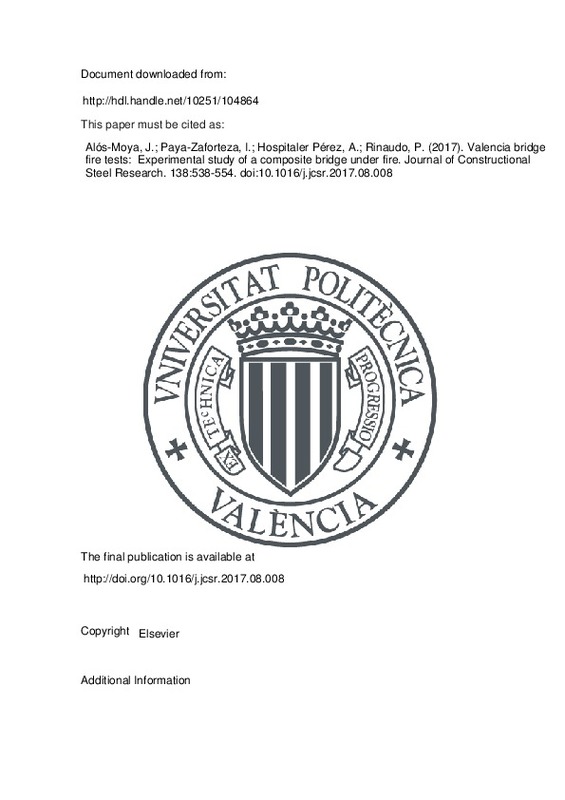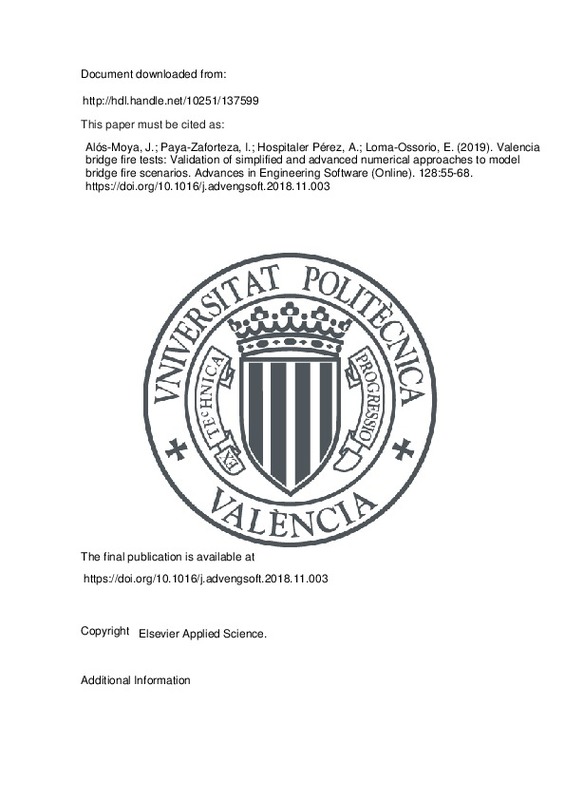JavaScript is disabled for your browser. Some features of this site may not work without it.
Buscar en RiuNet
Listar
Mi cuenta
Estadísticas
Ayuda RiuNet
Admin. UPV
A numerical investigation on the fire response of a steel girder bridge
Mostrar el registro sencillo del ítem
Ficheros en el ítem
| dc.contributor.author | Paya-Zaforteza, I.
|
es_ES |
| dc.contributor.author | Garlock, Maria E.M.
|
es_ES |
| dc.date.accessioned | 2015-02-13T10:43:38Z | |
| dc.date.available | 2015-02-13T10:43:38Z | |
| dc.date.issued | 2012-08 | |
| dc.identifier.issn | 0143-974X | |
| dc.identifier.uri | http://hdl.handle.net/10251/47010 | |
| dc.description.abstract | The response of bridges subject to fire is an under researched topic despite the number of bridge failures caused by fire. Since available data shows that steel girder bridges are especially vulnerable to fire, this paper delves into their fire response by analyzing with a 3D numerical model the response of a typical bridge of 12.20 m span length. A parametric study is performed considering: (1) two possibilities for the axial restraint of the bridge deck, (2) four types of structural steel for the girders (carbon steel and stainless steel grades 1.4301, 1.4401, and 1.4462), (3) three different constitutive models for carbon steel, (4) four live loads, and (5) two alternative fire loads (the hydrocarbon fire defined by Eurocode 1 and a fire corresponding to a real fire event). Results show that restraint to deck expansion coming from an adjacent span or abutment should be considered in the numerical model. In addition, times to collapse are very small when the bridge girders are built with carbon steel (between 8.5 and 18 min) but they can almost double if stainless steel is used for the girders. Therefore, stainless steel is a material to consider for steel girder bridges in a high fire risk situation, especially if the bridge is located in a corrosive environment and its aesthetics deserves special attention. The methodology developed in this paper and the results obtained are useful for researchers and practitioners interested in developing and applying a performance-based approach for the design of bridges against fire. © 2012 Elsevier Ltd. All rights reserved. | es_ES |
| dc.description.sponsorship | Funding for this research has been provided to Dr. Paya-Zaforteza by the Spanish Ministry of Education (contract number EX-2008-0669 of the Program for Postdoctoral Stays), the Spanish Ministry of Economy and Competitiveness (research project BIA 2011-27104) and the Universitat Politecnica de Valencia (Research and Development Support Program PAID-06-11). Funding has also been provided to Dr. Maria Garlock by the National Science Foundation (NSF) under award number CMMI-1068252. All opinions expressed in this paper are the authors' and do not necessarily reflect the policies and views of the sponsors. | en_EN |
| dc.language | Inglés | es_ES |
| dc.publisher | Elsevier | es_ES |
| dc.relation.ispartof | Journal of Constructional Steel Research | es_ES |
| dc.rights | Reserva de todos los derechos | es_ES |
| dc.subject | Bridge | es_ES |
| dc.subject | Carbon steel | es_ES |
| dc.subject | Fire | es_ES |
| dc.subject | Performance-based approach | es_ES |
| dc.subject | Stainless steel | es_ES |
| dc.subject | 3D numerical model | es_ES |
| dc.subject | Axial restraints | es_ES |
| dc.subject | Bridge failures | es_ES |
| dc.subject | Bridge girder | es_ES |
| dc.subject | Corrosive environment | es_ES |
| dc.subject | Eurocodes | es_ES |
| dc.subject | Fire loads | es_ES |
| dc.subject | Fire risks | es_ES |
| dc.subject | Hydrocarbon fire | es_ES |
| dc.subject | Live loads | es_ES |
| dc.subject | Numerical investigations | es_ES |
| dc.subject | Parametric study | es_ES |
| dc.subject | Real fire | es_ES |
| dc.subject | Span length | es_ES |
| dc.subject | Stainless steel grades | es_ES |
| dc.subject | Steel girder bridge | es_ES |
| dc.subject | Structural steels | es_ES |
| dc.subject | Bridges | es_ES |
| dc.subject | Building materials | es_ES |
| dc.subject | Numerical models | es_ES |
| dc.subject | Plate girder bridges | es_ES |
| dc.subject | Structural dynamics | es_ES |
| dc.subject | Three dimensional | es_ES |
| dc.subject | Fires | es_ES |
| dc.subject.classification | INGENIERIA CARTOGRAFICA, GEODESIA Y FOTOGRAMETRIA | es_ES |
| dc.subject.classification | PROYECTOS DE INGENIERIA | es_ES |
| dc.subject.classification | INGENIERIA DE LA CONSTRUCCION | es_ES |
| dc.title | A numerical investigation on the fire response of a steel girder bridge | es_ES |
| dc.type | Artículo | es_ES |
| dc.identifier.doi | 10.1016/j.jcsr.2012.03.012 | |
| dc.relation.projectID | info:eu-repo/grantAgreement/MICINN//EX2008-0669/ES/EX2008-0669/ | es_ES |
| dc.relation.projectID | info:eu-repo/grantAgreement/NSF//1068252/US/Collaborative Research: Fire Damage Mitigation and Post-Fire Evaluation of Steel Girder Bridges/ | es_ES |
| dc.relation.projectID | info:eu-repo/grantAgreement/MICINN//BIA2011-27104/ES/DEFINICION DE CONDICIONES DE MONITORIZACION, ENCAPSULADO Y FIJACION DE SENSORES OPTICOS PARA MEDIR TEMPERATURAS Y DEFORMACIONES EN ESTRUCTURAS SOMETIDAS A ALTAS TEMPERATURAS/ | es_ES |
| dc.relation.projectID | info:eu-repo/grantAgreement/UPV//PAID-06-11/ | es_ES |
| dc.rights.accessRights | Abierto | es_ES |
| dc.contributor.affiliation | Universitat Politècnica de València. Departamento de Ingeniería de la Construcción y de Proyectos de Ingeniería Civil - Departament d'Enginyeria de la Construcció i de Projectes d'Enginyeria Civil | es_ES |
| dc.description.bibliographicCitation | Paya-Zaforteza, I.; Garlock, ME. (2012). A numerical investigation on the fire response of a steel girder bridge. Journal of Constructional Steel Research. 75:93-103. https://doi.org/10.1016/j.jcsr.2012.03.012 | es_ES |
| dc.description.accrualMethod | S | es_ES |
| dc.relation.publisherversion | http://dx.doi.org/10.1016/j.jcsr.2012.03.012 | es_ES |
| dc.description.upvformatpinicio | 93 | es_ES |
| dc.description.upvformatpfin | 103 | es_ES |
| dc.type.version | info:eu-repo/semantics/publishedVersion | es_ES |
| dc.description.volume | 75 | es_ES |
| dc.relation.senia | 223572 | |
| dc.contributor.funder | National Science Foundation, EEUU | es_ES |
| dc.contributor.funder | Universitat Politècnica de València | es_ES |
| dc.contributor.funder | Ministerio de Ciencia e Innovación | es_ES |







![[Cerrado]](/themes/UPV/images/candado.png)




